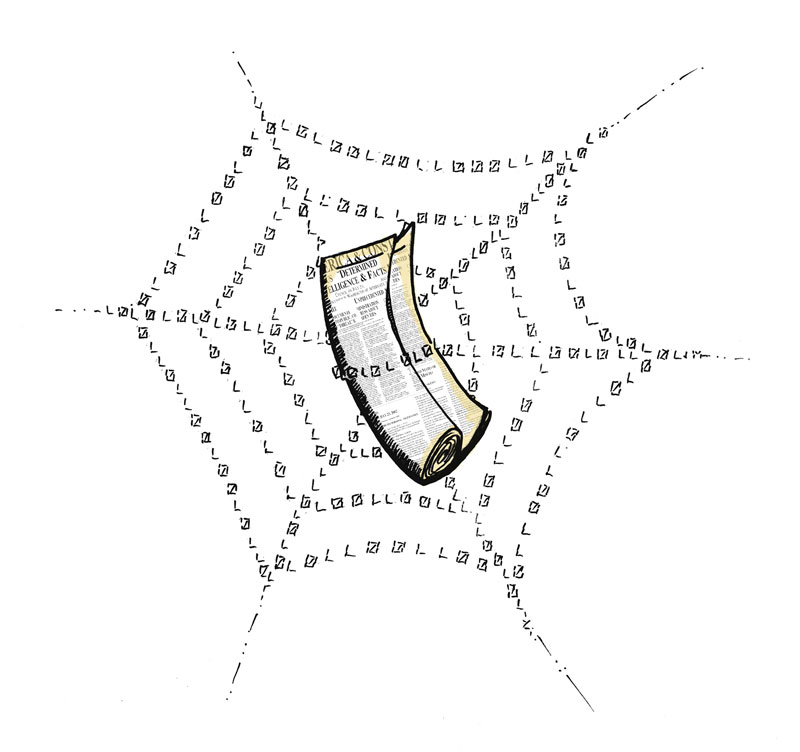For many of those reading this column on paper, the Daily Bruin is the only print journal they will hold today. It might even be the only newspaper to stain their fingers this month.
And yet, these same readers may be perfectly “caught-up on the news.” In conversation, they may speak of the countless nuances that make the Israeli-Palestinian conflict so difficult. They may lament activist judges, disparage Sarah Palin or weigh the relative benefits of the public option (but never all of the above).
The point? The Internet news media (part of what journalism snobs refer to as “New Media”) has arrived. The Web today hosts an extremely wide breadth of ever-increasingly subtle and informative reporting, and anyone still singing the relative praises of the print model simply refuses to face the breeze.
Print models that intend to survive the next decade (or half) must fully respect the relative advantages that the Internet model offers ““ and adjust their priorities accordingly.
According to a December 2008 projection by Deloitte that was reported on the Financial Times Web site, one-tenth of all journals and papers would have to reduce their frequency by more than half, closed their doors entirely or moved online.
Recently released data from the Newspaper Association of America shows that print advertising dropped 28 percent in the third quarter and that newspaper advertising has not had a quarterly gain since 2006.
Some print models are doing better than others in accepting the modernization of their industry.
Consider the case of the Guardian, the UK paper with a mere circulation of 350,000. Its online readership, according to the November Vanity Fair column by Michael Wolff titled “Rupert to Internet: It’s War,” adds up to 10 times that amount.
Even the New York Times is getting with it. The Gray Lady has a circulation that hovers nervously around one million, but its online audience is over 15 million.
Our own Daily Bruin launched an entirely revamped (and beefed-up) Web site with hopes to better connect with readers by facilitating dialogue through comments and ease of access through live streams and a more sensible home page.
But aside from the print outlets that have more or less successfully moved to the New Media world, there is a gamut of fine online-only options.
From The Daily Beast to the Huffington Post to Politico and Drudge Report (all dot-coms), there is a veritable plethora of content that caters to every subject and offers every viewpoint.
A prime example of Internet news legitimacy is the sum of Reza Aslan’s writing for The Daily Beast.
Aslan, through his contacts in Iran and his intimacy with Iranian history, was able to provide immediate, nuanced coverage of the summer’s Iranian presidential crisis not to be found elsewhere.
Of course, there are those among us who wax poetically about the great American tradition of the morning newspaper, this columnist included. Some of the people who fill these pages still dream of seeing their work on the ink-laden pages of the great Los Angeles and New York newspapers.
Oddly enough, Rupert Murdoch (News Corp., Fox, Fox News, general demonry) is just about the only bigwig left on our side.
The media mogul has decided that online readers of his content will have to pay for it, a risky strategy intended to push people back toward print that has not borne him much success and promises to hurt the journals in his fiefdom (with the worst blows falling on opinion columnists that thrive on cultivating weekly readers).
The problem with Murdoch’s plan ““ and just about any that stem from a refusal to accept that the Internet is the place we all go to read ““ is that he is shifting the burden of cost to the consumer.
As Wolff duly notes, “It is, after all, not the Internet that has made news free. News in penny-newspaper or broadcast (or bundled-cable) form has always been either free or negligibly priced. In almost every commercial iteration, news has been supported by advertising.”
Until the corporate side of journalism stops thinking of the Internet as the hedonistic den of viewers that will actually pay any number of dollars for content they can find at reputable free sites, they will continue to face losses like those Murdoch is accumulating (he lost $3 billion on his acquisition of the Wall Street Journal).
There are business models that pose viable options. Consider the case of The Daily Beast. Led by one of journalism’s most accomplished writers and editors (Tina Brown) and backed by the behemoth IAC (a conglomerate that garners about 200 million unique visitors worldwide), The Daily Beast has the fiscal stability to figure out what works as it evolves and grows. All this without the would-be threat of imperiling a print format at the same time.
Regardless of how newspapers make the transition to new media, it is always increasingly clear that the “when” is right now.
According to the State of the News Media 2009 report, this year’s end will mark 25 percent (more than 14,000) cuts in newspaper jobs since 2001.
But that’s a modest estimate; the morbid layoff news aggregator Paper Cuts has tallied up more than 14,571 jobs lost in 2009 alone.
Time is running out for print journalism, and it would be tragic if its biggest champions put themselves six feet under by refusing to adapt.
E-mail Makarechi at kmakarechi@media.ucla.edu. Send general comments to viewpoint@media.ucla.edu.
